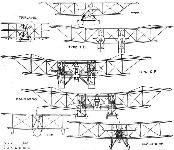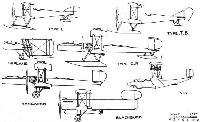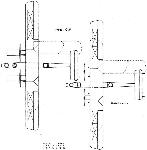
Описание
Страна: Великобритания
Год: 1916
Twin-engine, three-crew, three-bay biplane long-range patrol bomber seaplane
A.Jackson Blackburn Aircraft since 1909 (Putnam)
Blackburn G.P.
Lack of success with the twin-fuselage T.B. design prompted the Blackburn company to set about the construction of a more conventional twin-engined type. This was a three-seat, long-range, anti-submarine patrol bomber known as the G.P. or General Purpose seaplane. It had mainplanes of modified RAF 3 section, a long, slim fuselage of unusually small cross-section, inline water-cooled engines housed in nacelles on the lower mainplane and a large twin-ruddered biplane tail unit. Nevertheless, the G.P.'s long, wire-braced upper mainplane extensions and wide-track, divided float undercarriage proclaimed its T.B. ancestry, but this time the pontoons were bungee sprung and divided internally into twelve watertight compartments. For ease of storage the two-spar mainplanes folded backwards outboard of the engine nacelles, reducing the overall width to 27 ft 10 in.
Blackburns built only two of the type and these differed considerably in detail. The first, which appeared in July 1916 with the naval serial 1415, was powered by two opposite-handed 150 hp Sunbeam Nubian engines driving four-bladed airscrews and cooled by vertical radiator blocks clamped to struts at the rear of each nacelle.
Three crew members sat in open cockpits, with the bomb-aimer gunner in the nose, the pilot just ahead of the centre section and the rear gunner aft of the wings. A bomb sight was mounted externally on the starboard side of the front cockpit and, in addition to the two Scarff-mounted Lewis guns, armament consisted of four 230-lb bombs carried on racks under the wings. As there were no connecting struts between the main floats, alternative armament was a torpedo carried centrally under the fuselage. Although there is no evidence that the G.P. seaplane was ever airborne with a torpedo in position, it was one of the first British aircraft with this capability, and one of the first designed to carry W/T apparatus as standard equipment.
On completion, the G.P. seaplane went to the Isle of Grain for trials which included mooring in a rough sea for several days, an ordeal realistically described at the time as a 'destructive test'.
Meanwhile, the site for Blackburn's new aerodrome and seaplane base had been chosen on the River Humber at Brough, where the first experimental hangar and slipway were completed by the time the second G.P. seaplane was ready for erection later in 1916. Numbered 1416, this was a developed version of the original, and was sometimes known as the S.P. or Special Purpose seaplane. It was powered by two opposite-handed 190 hp Rolls-Royce engines (later named Falcons) cooled in the same manner as the Sunbeams and likewise driving four-bladed airscrews. However, unlike the Sunbeam engines of the first aircraft, the Rolls-Royces had exhaust manifolds on the outside walls of the cylinder blocks, making it convenient to run exhaust pipes along the sides instead of over the tops of the nacelles. Oil tanks were suspended between the inboard nacelle struts ahead of the radiator blocks.
The new machine was structurally stronger than 1415 through the greater use of heavier-gauge metal fittings, and whereas the first had ailerons only on the upper mainplane, the second boasted four ailerons - two of increased length on the upper mainplane connected by link struts of faired tubular steel to short-span units on the lower wing. A wire trailing edge, first employed on the Triplane, was also used for all flying and control surfaces, so that unlike 1415 which had straight edges, those of 1416 were of the familiar scalloped pattern. It was, in fact, a retrograde step as wire trailing edges on seaplanes were a constant source of trouble because they rusted through and split the fabric.
In a lecture given before the Brough branch of the Royal Aeronautical Society in November 1958, G. E. Petty recalled the nightmare of conducting manufacturer's trials on the G.P. seaplane in midwinter with drift ice on the Humber. Launching was simple and the first flight successful, but the strong tide made recovery difficult, and the wading team led by Robert Blackburn's brother-in-law, R. R. Rhodes, were literally frozen stiff and had to be carried in on planks and thawed out in front of fires lighted in the hangar. Afterwards the machine was flown to the Great Yarmouth Air Station for Service trials but did not secure a production contract. Nevertheless a landplane version was built in small numbers as the Blackburn Kangaroo.
SPECIFICATION AND DATA
Manufacturers: The Blackburn Aeroplane and Motor Co Ltd, Olympia Works, Leeds, and Brough, East Yorks.
Power Plants:
Two 150 hp Sunbeam Nubian
Two 190 hp Rolls-Royce
Dimensions:
Span (upper) 71 ft 10] in (lower) 52 ft 10.1 in
Length 46 ft 0 in Height 16 ft 10 in
Wing area 880 sq ft
Weights:
(Sunbeam) All-up weight 8,100 lb
(Rolls-Royce) Tare weight 5,840 lb All-up weight 8,600 lb
Performance: (Rolls-Royce)
Maximum speed at sea level 97 mph
Climb to 5,000 ft 10 min
Ceiling 11,000 ft Endurance 8 hr
Production: Two aircraft only.
1415 with Sunbeam engines, first flown at RNAS Isle of Grain July 1916.
1416 with Rolls-Royce engines, first flown at Brough late 1916 and delivered to the Great Yarmouth Air Station.
Описание:
- A.Jackson Blackburn Aircraft since 1909 (Putnam)
- F.Manson British Bomber Since 1914 (Putnam)
- P.Lewis British Bomber since 1914 (Putnam)
- J.Bruce British Aeroplanes 1914-1918 (Putnam)
- H.King Armament of British Aircraft (Putnam)
- Журнал Flight
Фотографии
-
P.Lewis - British Bomber since 1914 /Putnam/
The first Blackburn G.P. seaplane, 1415, at the RNAS experimental establishment, Isle of Grain, in 1916.
-
J.Bruce - British Aeroplanes 1914-1918 /Putnam/
The first Blackburn GP seaplane, No 1415 powered by Sunbeam engines, at RNAS Isle of Grain in 1916. Note the use of a tailfloat, made necessary by the relatively short mam floats. It is not thought likely that a GP ever carried a torpedo into the air.
Only two examples of the three-seat Blackburn GP long range patrol and torpedo bomber were built, the first being completed in July 1916. These two contemporaries and rivals to the Short Type 310 differed in both structural detail and the type of engine employed. The first example, serial no 1415 seen here, used twin 150hp Sunbeam Nubians, while serial no 1416, which did not emerge until near the close of 1916, was powered by twin 190hp Rolls-Royce Falcons. The top level speed of the latter floatplane was 97mph at sea level, its ceiling 11.000 feet and climb to 5,000 feet took 10 minutes. Armament comprised two flexibly-mounted .303-inch Lewis guns, plus a 14-inch torpedo, or four 230lb bombs. The Admiralty elected not to proceed with further development, but a landplane version, powered by twin 270hp Rolls-Royce Falcon IIIs and known as the Blackburn Kangaroo was subsequently produced for the RFC, who took 20 examples. -
A.Jackson - Blackburn Aircraft since 1909 /Putnam/
The second G.P. seaplane, 1416, at Brough in 1916 showing the raised nacelles and ailerons on all four wings.
-
J.Bruce - British Aeroplanes 1914-1918 /Putnam/
The second G.P. seaplane 1416 ready for launching and showing the scalloped trailing edges to all flying surfaces.
This illustration shows the feathered trailing edges of the rudders, and the enlarged upper ailerons. -
A.Jackson - Blackburn Aircraft since 1909 /Putnam/
Launching G.P. seaplane 1416 at the Isle of Grain in 1916.
-
Журнал - Flight за 1919 г.
Front elevations of the Blackburn machines
Другие самолёты на фотографии: Blackburn Blackburd - Великобритания - 1918Blackburn Kangaroo / R.T.1 - Великобритания - 1917Blackburn N.1B - Великобритания - 1918Blackburn TB - Великобритания - 1915Blackburn Triplane - Великобритания - 1916Blackburn Type L - Великобритания - 1914
-
Журнал - Flight за 1919 г.
Side elevations of the Blackburn machines
Другие самолёты на фотографии: Blackburn Blackburd - Великобритания - 1918Blackburn Kangaroo / R.T.1 - Великобритания - 1917Blackburn N.1B - Великобритания - 1918Blackburn TB - Великобритания - 1915Blackburn Triplane - Великобритания - 1916Blackburn Type L - Великобритания - 1914
-
Журнал - Flight за 1919 г.
Plan views of Blackburn machines
Другие самолёты на фотографии: Blackburn Kangaroo / R.T.1 - Великобритания - 1917
-
A.Jackson - Blackburn Aircraft since 1909 /Putnam/
Blackburn G.P. Seaplane









